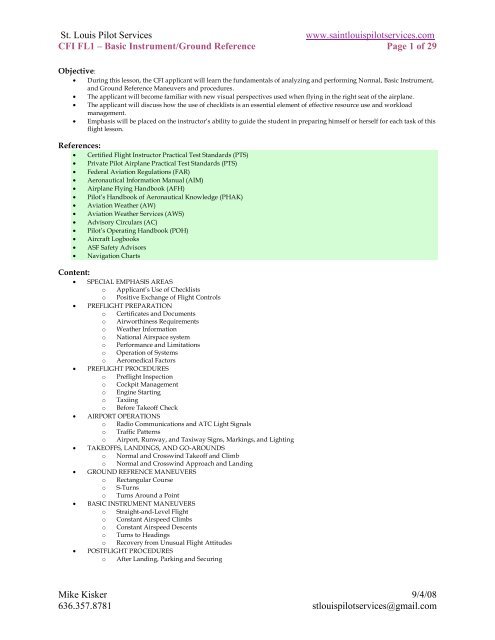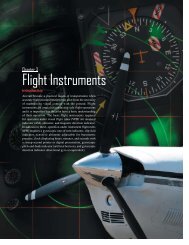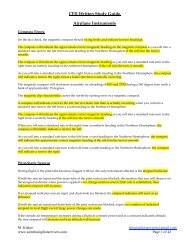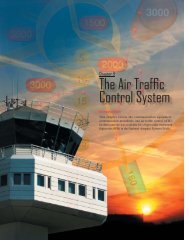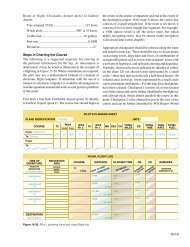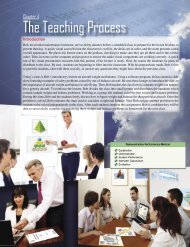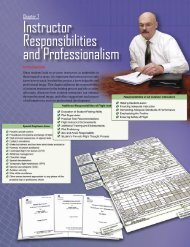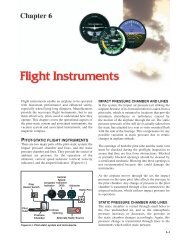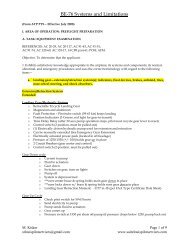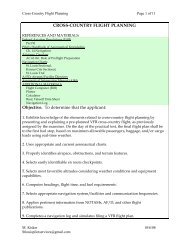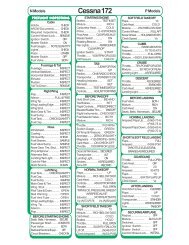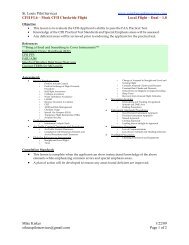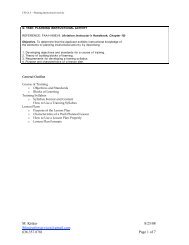CFI FL1 - Basic Instrument and Ground Reference - St. Louis Pilot ...
CFI FL1 - Basic Instrument and Ground Reference - St. Louis Pilot ...
CFI FL1 - Basic Instrument and Ground Reference - St. Louis Pilot ...
You also want an ePaper? Increase the reach of your titles
YUMPU automatically turns print PDFs into web optimized ePapers that Google loves.
<strong>St</strong>. <strong>Louis</strong> <strong>Pilot</strong> Services<br />
www.saintlouispilotservices.com<br />
<strong>CFI</strong> <strong>FL1</strong> – <strong>Basic</strong> <strong>Instrument</strong>/<strong>Ground</strong> <strong>Reference</strong> Page 1 of 29<br />
Objective:<br />
• During this lesson, the <strong>CFI</strong> applicant will learn the fundamentals of analyzing <strong>and</strong> performing Normal, <strong>Basic</strong> <strong>Instrument</strong>,<br />
<strong>and</strong> <strong>Ground</strong> <strong>Reference</strong> Maneuvers <strong>and</strong> procedures.<br />
• The applicant will become familiar with new visual perspectives used when flying in the right seat of the airplane.<br />
• The applicant will discuss how the use of checklists is an essential element of effective resource use <strong>and</strong> workload<br />
management.<br />
• Emphasis will be placed on the instructor’s ability to guide the student in preparing himself or herself for each task of this<br />
flight lesson.<br />
<strong>Reference</strong>s:<br />
• Certified Flight Instructor Practical Test <strong>St</strong><strong>and</strong>ards (PTS)<br />
• Private <strong>Pilot</strong> Airplane Practical Test <strong>St</strong><strong>and</strong>ards (PTS)<br />
• Federal Aviation Regulations (FAR)<br />
• Aeronautical Information Manual (AIM)<br />
• Airplane Flying H<strong>and</strong>book (AFH)<br />
• <strong>Pilot</strong>’s H<strong>and</strong>book of Aeronautical Knowledge (PHAK)<br />
• Aviation Weather (AW)<br />
• Aviation Weather Services (AWS)<br />
• Advisory Circulars (AC)<br />
• <strong>Pilot</strong>’s Operating H<strong>and</strong>book (POH)<br />
• Aircraft Logbooks<br />
• ASF Safety Advisors<br />
• Navigation Charts<br />
Content:<br />
• SPECIAL EMPHASIS AREAS<br />
o Applicant’s Use of Checklists<br />
o Positive Exchange of Flight Controls<br />
• PREFLIGHT PREPARATION<br />
o Certificates <strong>and</strong> Documents<br />
o Airworthiness Requirements<br />
o Weather Information<br />
o National Airspace system<br />
o Performance <strong>and</strong> Limitations<br />
o Operation of Systems<br />
o Aeromedical Factors<br />
• PREFLIGHT PROCEDURES<br />
o Preflight Inspection<br />
o Cockpit Management<br />
o Engine <strong>St</strong>arting<br />
o Taxiing<br />
o Before Takeoff Check<br />
• AIRPORT OPERATIONS<br />
o Radio Communications <strong>and</strong> ATC Light Signals<br />
o Traffic Patterns<br />
o Airport, Runway, <strong>and</strong> Taxiway Signs, Markings, <strong>and</strong> Lighting<br />
• TAKEOFFS, LANDINGS, AND GO-AROUNDS<br />
o Normal <strong>and</strong> Crosswind Takeoff <strong>and</strong> Climb<br />
o Normal <strong>and</strong> Crosswind Approach <strong>and</strong> L<strong>and</strong>ing<br />
• GROUND REFRENCE MANEUVERS<br />
o Rectangular Course<br />
o S-Turns<br />
o Turns Around a Point<br />
• BASIC INSTRUMENT MANEUVERS<br />
o <strong>St</strong>raight-<strong>and</strong>-Level Flight<br />
o Constant Airspeed Climbs<br />
o Constant Airspeed Descents<br />
o Turns to Headings<br />
o Recovery from Unusual Flight Attitudes<br />
• POSTFLIGHT PROCEDURES<br />
o After L<strong>and</strong>ing, Parking <strong>and</strong> Securing<br />
Mike Kisker 9/4/08<br />
636.357.8781 stlouispilotservices@gmail.com
<strong>St</strong>. <strong>Louis</strong> <strong>Pilot</strong> Services<br />
www.saintlouispilotservices.com<br />
<strong>CFI</strong> <strong>FL1</strong> – <strong>Basic</strong> <strong>Instrument</strong>/<strong>Ground</strong> <strong>Reference</strong> Page 2 of 29<br />
Special Emphasis Area: Applicant's Use of Checklists<br />
REFERENCE:<br />
Private <strong>Pilot</strong> PTS<br />
o Special Emphasis Areas (checklist usage)<br />
o Page 8 “Applicant’s Use of Checklists”<br />
o All Maneuvers “Completes the Appropriate Checklist”<br />
Airplane Flying H<strong>and</strong>book<br />
o Page 1-6 “Use of Checklists”<br />
Appropriate Checklist<br />
o Review Checklist content<br />
“Throughout the practical test, the applicant is evaluated on the use of an appropriate checklist. Proper<br />
use is dependent on the specific TASK being evaluated. The situation may be such that the use of the<br />
checklist, while accomplishing elements of an Objective, would be either unsafe or impractical, especially<br />
in a single-pilot operation. In this case, a review of the checklist after the elements have been<br />
accomplished, would be appropriate. Division of attention <strong>and</strong> proper visual scanning should be<br />
considered when using a checklist.”<br />
Mike Kisker 9/4/08<br />
636.357.8781 stlouispilotservices@gmail.com
<strong>St</strong>. <strong>Louis</strong> <strong>Pilot</strong> Services<br />
www.saintlouispilotservices.com<br />
<strong>CFI</strong> <strong>FL1</strong> – <strong>Basic</strong> <strong>Instrument</strong>/<strong>Ground</strong> <strong>Reference</strong> Page 3 of 29<br />
Special Emphasis Area: Positive Exchange of Flight Controls<br />
REFERENCE:<br />
Private <strong>Pilot</strong> PTS<br />
o P. 5: Special Emphasis Area #2 – Procedures for positive exchange of flight controls<br />
o P. 9: Positive Exchange of Flight Controls - Explained<br />
Airplane Flying H<strong>and</strong>book<br />
o Ch. 1, page 6: Positive Transfer of Controls<br />
During flight training, there must always be a clear underst<strong>and</strong>ing between students <strong>and</strong> flight<br />
instructors of who has control of the aircraft. Prior to flight, a briefing should be conducted that<br />
includes the procedure for the exchange of flight controls. A positive three-step process in the<br />
exchange of flight controls between pilots is a proven procedure <strong>and</strong> one that is strongly<br />
recommended.<br />
When the instructor wishes the student to take control of the aircraft, he or she will say, “You<br />
have the flight controls.” The student acknowledges immediately by saying, “I have the flight<br />
controls.” The flight instructor again says, “You have the flight controls.” When control is<br />
returned to the instructor, follow the same procedure. A visual check is recommended to verify<br />
that the exchange has occurred. There should never by any doubt as to who is flying the<br />
aircraft.<br />
Mike Kisker 9/4/08<br />
636.357.8781 stlouispilotservices@gmail.com
<strong>St</strong>. <strong>Louis</strong> <strong>Pilot</strong> Services<br />
www.saintlouispilotservices.com<br />
<strong>CFI</strong> <strong>FL1</strong> – <strong>Basic</strong> <strong>Instrument</strong>/<strong>Ground</strong> <strong>Reference</strong> Page 4 of 29<br />
A. TASK: CERTIFICATES AND DOCUMENTS (PVT)<br />
REFERENCES:<br />
Federal Aviation Regulations (FAR)<br />
o 43.3: Persons Authorized to Perform Maintenance<br />
o 43.7(f): Persons Authorized to Approve Aircraft for Return to Service<br />
o 43 Appendix A: Major Alterations, Major Repairs, <strong>and</strong> Preventative Maintenance<br />
o 61.23: Medical Certificates: Requirement <strong>and</strong> Duration<br />
o 61.51: <strong>Pilot</strong> Logbooks<br />
o 61.57: Recent Flight Experience: <strong>Pilot</strong>-in-Comm<strong>and</strong><br />
o 61.113: Private <strong>Pilot</strong> Privileges <strong>and</strong> Limitations: <strong>Pilot</strong> in Comm<strong>and</strong><br />
<strong>Pilot</strong>’s H<strong>and</strong>book of Aeronautical Knowledge (PHAK)<br />
o Chapter 7: Flight Manuals <strong>and</strong> Other Documents<br />
<strong>Pilot</strong>’s Operating H<strong>and</strong>book (POH)<br />
o Section 2: Limitations<br />
o Section 6: Weight & Balance/Equipment List<br />
Objective. To determine that the applicant exhibits knowledge of the elements related to certificates <strong>and</strong><br />
documents by:<br />
1. Explaining—<br />
a. Private pilot certificate privileges, limitations, <strong>and</strong> recent flight experience requirements.<br />
b. Medical certificate class <strong>and</strong> duration.<br />
c. <strong>Pilot</strong> logbook or flight records.<br />
2. Locating <strong>and</strong> explaining—<br />
a. Airworthiness <strong>and</strong> registration certificates.<br />
b. Operating limitations, placards, instrument markings, <strong>and</strong><br />
c. Weight <strong>and</strong> balance data <strong>and</strong> equipment list.<br />
Mike Kisker 9/4/08<br />
636.357.8781 stlouispilotservices@gmail.com
<strong>St</strong>. <strong>Louis</strong> <strong>Pilot</strong> Services<br />
www.saintlouispilotservices.com<br />
<strong>CFI</strong> <strong>FL1</strong> – <strong>Basic</strong> <strong>Instrument</strong>/<strong>Ground</strong> <strong>Reference</strong> Page 5 of 29<br />
B. TASK: AIRWORTHINESS REQUIREMENTS (PVT)<br />
REFERENCES:<br />
Federal Aviation Regulations<br />
o 91.409: Annual Inspection<br />
o 91.171: VOR Check<br />
o 91.409: I00-Hour Inspection<br />
o 91.411: Altimeter/Pitot-<strong>St</strong>atic System Check<br />
o 91.413: Transponder Inspection<br />
o 91.207: ELT Inspection <strong>and</strong> ELT Battery Replacement<br />
Aircraft Logbooks<br />
o Instructor must sign them out from maintenance hangar<br />
o Fill out Aircraft Inspection Summary Sheet<br />
<strong>Pilot</strong>’s H<strong>and</strong>book of Aeronautical Knowledge,<br />
o P. 7-7 Aircraft Inspections<br />
Objective. To determine that the applicant exhibits knowledge of the elements related to airworthiness<br />
requirements by:<br />
1. Explaining—<br />
a. required instruments <strong>and</strong> equipment for day/night VFR.<br />
b. procedures <strong>and</strong> limitations for determining airworthiness of the airplane with inoperative<br />
instruments <strong>and</strong> equipment with <strong>and</strong> without an MEL.<br />
c. requirements <strong>and</strong> procedures for obtaining a special flight permit.<br />
2. Locating <strong>and</strong> explaining—<br />
a. airworthiness directives.<br />
b. compliance records.<br />
c. maintenance/inspection requirements.<br />
d. appropriate record keeping.<br />
Mike Kisker 9/4/08<br />
636.357.8781 stlouispilotservices@gmail.com
<strong>St</strong>. <strong>Louis</strong> <strong>Pilot</strong> Services<br />
www.saintlouispilotservices.com<br />
<strong>CFI</strong> <strong>FL1</strong> – <strong>Basic</strong> <strong>Instrument</strong>/<strong>Ground</strong> <strong>Reference</strong> Page 6 of 29<br />
C. TASK: WEATHER INFORMATION (PVT)<br />
REFERENCES:<br />
Federal Aviation Regulations (FAR)<br />
91.155: <strong>Basic</strong> VFR Weather Minimums<br />
Aviation Weather (AW)<br />
Aviation Weather Services (AWS)<br />
Section 2: Aviation Routine Weather Report (METAR)<br />
Section 4: Aviation Weather Forecasts<br />
Section 5: Surface Analysis Chart<br />
Section 10: Winds <strong>and</strong> Temperatures Aloft Chart<br />
Section 11: Significant Weather Prognostic Chart<br />
Section 12: Convective Outlook Chart<br />
<strong>Pilot</strong>’s H<strong>and</strong>book of Aeronautical Knowledge (PHAK)<br />
Chapter 10: Weather Theory<br />
Chapter 11: Weather Reports, Forecasts, <strong>and</strong> Charts<br />
Advisory Circulars (AC)<br />
AC 61-84: Role of Preflight Preparation<br />
Aeronautical Information Manual (AIM)<br />
Chapter 7, Section 1: Meteorology<br />
Objective. To determine that the applicant:<br />
1. Exhibits knowledge of the elements related to weather information by analyzing weather reports,<br />
charts, <strong>and</strong> forecasts from various sources with emphasis on—<br />
a. METAR, TAF, <strong>and</strong> FA.<br />
b. Surface analysis chart.<br />
c. Radar summary chart.<br />
d. Winds <strong>and</strong> temperature aloft chart.<br />
e. Significant weather prognostic charts.<br />
f. Convective outlook chart.<br />
g. AWOS, ASOS, <strong>and</strong> ATIS reports.<br />
2. Makes a competent “go/no-go” decision based on available weather information.<br />
Mike Kisker 9/4/08<br />
636.357.8781 stlouispilotservices@gmail.com
<strong>St</strong>. <strong>Louis</strong> <strong>Pilot</strong> Services<br />
www.saintlouispilotservices.com<br />
<strong>CFI</strong> <strong>FL1</strong> – <strong>Basic</strong> <strong>Instrument</strong>/<strong>Ground</strong> <strong>Reference</strong> Page 7 of 29<br />
E. TASK: NATIONAL AIRSPACE SYSTEM (PVT)<br />
REFERENCES:<br />
<strong>Pilot</strong>’s H<strong>and</strong>book of Aeronautical Knowledge (PHAK)<br />
Chapter 13: Airspace<br />
Federal Aviation Regulations<br />
Part 71: Airspace<br />
Part 73: Special Use Airspace<br />
Part 91: General Operating & Flight Rules<br />
Navigation Charts<br />
Kansas City Sectional Chart<br />
<strong>St</strong>. <strong>Louis</strong> Sectional Chart<br />
<strong>St</strong>. <strong>Louis</strong> Terminal Area Chart<br />
Aeronautical Information Manual (AIM)<br />
Chapter 3: Airspace<br />
Objective. To determine that the applicant exhibits knowledge of the elements related to the National<br />
Airspace System by explaining:<br />
1. <strong>Basic</strong> VFR weather minimums—for all classes of airspace.<br />
2. Airspace classes—their operating rules, pilot certification, <strong>and</strong> airplane equipment requirements for the<br />
following—<br />
a. Class A.<br />
b. Class B.<br />
c. Class C.<br />
d. Class D.<br />
e. Class E.<br />
f. Class G.<br />
3. Special use <strong>and</strong> other airspace areas.<br />
Mike Kisker 9/4/08<br />
636.357.8781 stlouispilotservices@gmail.com
<strong>St</strong>. <strong>Louis</strong> <strong>Pilot</strong> Services<br />
www.saintlouispilotservices.com<br />
<strong>CFI</strong> <strong>FL1</strong> – <strong>Basic</strong> <strong>Instrument</strong>/<strong>Ground</strong> <strong>Reference</strong> Page 8 of 29<br />
F. TASK: PERFORMANCE AND LIMITATIONS (PVT)<br />
REFERENCES:<br />
Federal Aviation Regulations (FAR)<br />
91.103: Preflight Action<br />
<strong>Pilot</strong>’s H<strong>and</strong>book of Aeronautical Knowledge<br />
Chapter 9: Aircraft Performance<br />
Aircraft Weight <strong>and</strong> Balance H<strong>and</strong>book<br />
Chapter 1: Weight <strong>and</strong> Balance Control<br />
Chapter 2: Weight <strong>and</strong> Balance Theory <strong>and</strong> Documentation<br />
Chapter 4: Small Fixed Wing Aircraft Operational Weight <strong>and</strong> Balance Computations<br />
Advisory Circulars<br />
AC 61-84: Role of Preflight Preparation<br />
<strong>Pilot</strong>’s Operating H<strong>and</strong>book (POH)<br />
Section 2: Limitations<br />
Section 5: Performance<br />
Section 6: Weight & Balance <strong>and</strong> Equipment List<br />
Objective. To determine that the applicant:<br />
1. Exhibits knowledge of the elements related to performance <strong>and</strong> limitations by explaining the use of<br />
charts, tables, <strong>and</strong> data to determine performance <strong>and</strong> the adverse effects of exceeding limitations.<br />
2. Computes weight <strong>and</strong> balance. Determines the computed weight <strong>and</strong> center of gravity is within the<br />
airplane’s operating limitations <strong>and</strong> if the weight <strong>and</strong> center of gravity will remain within limits during<br />
all phases of flight.<br />
3. Demonstrates use of the appropriate performance charts, tables, <strong>and</strong> data.<br />
4. Describes the effects of atmospheric conditions on the airplane's performance.<br />
Mike Kisker 9/4/08<br />
636.357.8781 stlouispilotservices@gmail.com
<strong>St</strong>. <strong>Louis</strong> <strong>Pilot</strong> Services<br />
www.saintlouispilotservices.com<br />
<strong>CFI</strong> <strong>FL1</strong> – <strong>Basic</strong> <strong>Instrument</strong>/<strong>Ground</strong> <strong>Reference</strong> Page 9 of 29<br />
G. TASK: OPERATION OF SYSTEMS (PVT)<br />
REFERENCE:<br />
<strong>Pilot</strong>’s Operating H<strong>and</strong>book<br />
o Section 7: Systems<br />
<strong>Pilot</strong>’s H<strong>and</strong>book of Aeronautical Knowledge<br />
o Chapter 5: Aircraft Systems<br />
Objective. To determine that the applicant exhibits knowledge of the elements related to the operation of<br />
systems on the airplane provided for the flight test by explaining at least three (3) of the following<br />
systems.<br />
1. Primary flight controls <strong>and</strong> trim.<br />
2. Flaps, leading edge devices, <strong>and</strong> spoilers.<br />
3. Powerplant <strong>and</strong> propeller.<br />
4. L<strong>and</strong>ing gear.<br />
5. Fuel, oil, <strong>and</strong> hydraulic.<br />
6. Electrical.<br />
7. Avionics<br />
8. Pitot-static vacuum/pressure <strong>and</strong> associated flight instruments.<br />
9. Environmental.<br />
10. Deicing <strong>and</strong> anti-icing.<br />
Mike Kisker 9/4/08<br />
636.357.8781 stlouispilotservices@gmail.com
<strong>St</strong>. <strong>Louis</strong> <strong>Pilot</strong> Services<br />
www.saintlouispilotservices.com<br />
<strong>CFI</strong> <strong>FL1</strong> – <strong>Basic</strong> <strong>Instrument</strong>/<strong>Ground</strong> <strong>Reference</strong> Page 10 of 29<br />
TASK J: Aeromedical Factors (PVT)<br />
REFERENCES:<br />
Aeronautical Information Manual (AIM)<br />
Chapter 8: Medical Facts for <strong>Pilot</strong>s<br />
<strong>Pilot</strong>’s H<strong>and</strong>book of Aeronautical Knowledge (PHAK)<br />
Chapter 15: Aeromedical Factors<br />
Objective. To determine that the applicant exhibits knowledge of the elements related to aeromedical<br />
factors by explaining:<br />
1. The symptoms, causes, effects, <strong>and</strong> corrective actions of at least three (3) of the following—<br />
a. Hypoxia.<br />
b. Hyperventilation.<br />
c. Middle ear <strong>and</strong> sinus problems.<br />
d. Spatial disorientation.<br />
e. Motion sickness.<br />
f. Carbon monoxide poisoning.<br />
g. <strong>St</strong>ress <strong>and</strong> fatigue.<br />
h. Dehydration.<br />
2. The effects of alcohol, drugs, <strong>and</strong> over-the-counter medications.<br />
3. The effects of excesses nitrogen during scuba dives upon a pilot or passenger in flight.<br />
Mike Kisker 9/4/08<br />
636.357.8781 stlouispilotservices@gmail.com
<strong>St</strong>. <strong>Louis</strong> <strong>Pilot</strong> Services<br />
www.saintlouispilotservices.com<br />
<strong>CFI</strong> <strong>FL1</strong> – <strong>Basic</strong> <strong>Instrument</strong>/<strong>Ground</strong> <strong>Reference</strong> Page 11 of 29<br />
REFERENCE:<br />
Airplane Flying H<strong>and</strong>book,<br />
o Chapter 2, page 1 “Visual Inspection”<br />
<strong>Pilot</strong>’s Operating H<strong>and</strong>book,<br />
o Chapter 4: Normal Operations<br />
Objective. To determine that the applicant:<br />
A. TASK: PREFLIGHT INSPECTION (PVT)<br />
1. Exhibits knowledge of the elements related to preflight inspection. This shall include which items must<br />
be inspected, the reasons for checking each item, <strong>and</strong> how to detect possible defects.<br />
2. Inspects the airplane with reference to an appropriate checklist.<br />
3. Verifies the airplane is in condition for safe flight.<br />
Mike Kisker 9/4/08<br />
636.357.8781 stlouispilotservices@gmail.com
<strong>St</strong>. <strong>Louis</strong> <strong>Pilot</strong> Services<br />
www.saintlouispilotservices.com<br />
<strong>CFI</strong> <strong>FL1</strong> – <strong>Basic</strong> <strong>Instrument</strong>/<strong>Ground</strong> <strong>Reference</strong> Page 12 of 29<br />
B. TASK: COCKPIT MANAGEMENT (PVT)<br />
REFERENCES:<br />
Airplane Flying H<strong>and</strong>book (AFH)<br />
Chapter 2, Page 7: Cockpit Management<br />
Objective. To determine that the applicant:<br />
1. Exhibits knowledge of the elements related to cockpit management procedures.<br />
2. Ensures all loose items in the cockpit <strong>and</strong> cabin are secured.<br />
3. Organizes material <strong>and</strong> equipment in an efficient manner so they are readily available.<br />
4. Briefs occupants on the use of safety belts, shoulder harnesses, doors, <strong>and</strong> emergency procedures.<br />
Mike Kisker 9/4/08<br />
636.357.8781 stlouispilotservices@gmail.com
<strong>St</strong>. <strong>Louis</strong> <strong>Pilot</strong> Services<br />
www.saintlouispilotservices.com<br />
<strong>CFI</strong> <strong>FL1</strong> – <strong>Basic</strong> <strong>Instrument</strong>/<strong>Ground</strong> <strong>Reference</strong> Page 13 of 29<br />
REFERENCE:<br />
Airplane Flying H<strong>and</strong>book<br />
Chapter 2, p. 7: Engine <strong>St</strong>arting<br />
<strong>Pilot</strong>’s Operating H<strong>and</strong>book<br />
Section 4: Normal Procedures<br />
Appropriate Checklist<br />
C. TASK: ENGINE STARTING (PVT)<br />
Objective. To determine that the applicant:<br />
1. Exhibits knowledge of the elements related to recommended engine starting procedures. This shall<br />
include the use of an external power source, h<strong>and</strong> propping safety, <strong>and</strong> starting under various<br />
atmospheric conditions.<br />
2. Positions the airplane properly considering structures, surface conditions, other aircraft, <strong>and</strong> the safety<br />
of nearby persons <strong>and</strong> property.<br />
3. Utilizes the appropriate checklist for starting procedure.<br />
Mike Kisker 9/4/08<br />
636.357.8781 stlouispilotservices@gmail.com
<strong>St</strong>. <strong>Louis</strong> <strong>Pilot</strong> Services<br />
www.saintlouispilotservices.com<br />
<strong>CFI</strong> <strong>FL1</strong> – <strong>Basic</strong> <strong>Instrument</strong>/<strong>Ground</strong> <strong>Reference</strong> Page 14 of 29<br />
D. TASK: TAXIING (PVT)<br />
REFERENCE:<br />
Airplane Flying H<strong>and</strong>book<br />
Chapter 2, page 9: Taxiing<br />
<strong>Pilot</strong>’s H<strong>and</strong>book of Aeronautical Knowledge<br />
Chapter 12, page 3: Airport Markings <strong>and</strong> Signs<br />
<strong>Pilot</strong>’s Operating H<strong>and</strong>book<br />
Section 4: Normal Procedures<br />
Aeronautical Information Manual<br />
Chapter 2: Aeronautical Lighting <strong>and</strong> Other Airport Visual Aids (signs, markings, <strong>and</strong> lighting)<br />
Appropriate Checklist<br />
Objective. To determine that the applicant:<br />
1. Exhibits knowledge of the elements related to safe taxi procedures.<br />
2. Performs a brake check immediately after the airplane begins moving.<br />
3. Positions the flight controls properly for the existing wind conditions.<br />
4. Controls direction <strong>and</strong> speed without excessive use of brakes.<br />
5. Complies with airport/taxiway markings, signals, ATC clearances, <strong>and</strong> instructions.<br />
6. Taxies so as to avoid other aircraft <strong>and</strong> hazards.<br />
Mike Kisker 9/4/08<br />
636.357.8781 stlouispilotservices@gmail.com
<strong>St</strong>. <strong>Louis</strong> <strong>Pilot</strong> Services<br />
www.saintlouispilotservices.com<br />
<strong>CFI</strong> <strong>FL1</strong> – <strong>Basic</strong> <strong>Instrument</strong>/<strong>Ground</strong> <strong>Reference</strong> Page 15 of 29<br />
F. TASK: BEFORE TAKEOFF CHECK (PVT)<br />
REFERENCE:<br />
Airplane Flying H<strong>and</strong>book,<br />
Chapter 2, page 11: Before Takeoff Check<br />
<strong>Pilot</strong>’s Operating H<strong>and</strong>book<br />
Section 4: Normal Operations<br />
Appropriate Checklist<br />
Become familiar with the “Before Takeoff” checklist<br />
Objective. To determine that the applicant:<br />
1. Exhibits knowledge of the elements related to the before takeoff check. This shall include the reasons<br />
for checking each item <strong>and</strong> how to detect malfunctions.<br />
2. Positions the airplane properly considering other aircraft/vessels, wind <strong>and</strong> surface conditions.<br />
3. Divides attention inside <strong>and</strong> outside the cockpit.<br />
4. Ensures that engine temperature <strong>and</strong> pressure are suitable for run-up <strong>and</strong> takeoff.<br />
5. Accomplishes the before takeoff checklist <strong>and</strong> ensures the airplane is in safe operating condition.<br />
6. Reviews takeoff performance airspeeds, takeoff distances, departure, <strong>and</strong> emergency procedures.<br />
7. Avoids runway incursions <strong>and</strong>/or ensures no conflict with traffic prior to taxiing into takeoff position.<br />
Mike Kisker 9/4/08<br />
636.357.8781 stlouispilotservices@gmail.com
<strong>St</strong>. <strong>Louis</strong> <strong>Pilot</strong> Services<br />
www.saintlouispilotservices.com<br />
<strong>CFI</strong> <strong>FL1</strong> – <strong>Basic</strong> <strong>Instrument</strong>/<strong>Ground</strong> <strong>Reference</strong> Page 16 of 29<br />
A. TASK: RADIO COMMUNICATIONS AND ATC LIGHT SIGNALS (PVT)<br />
REFERENCE:<br />
Federal Aviation Regulations<br />
91.123: Compliance with ATC Clearances <strong>and</strong> Instructions<br />
91.125: ATC Light Signals<br />
91.131: Operations in Class B Airspace<br />
<strong>Pilot</strong>’s H<strong>and</strong>book of Aeronautical Knowledge<br />
Chapter 12, page 8: Radio Communications<br />
<strong>St</strong>. <strong>Louis</strong> Terminal Area Chart (TAC)<br />
Find radio frequencies for CTAF, Tower, Approach, AWOS, ATIS, <strong>and</strong> FSS<br />
Aeronautical Information Manual<br />
Chapter 4, Section 2: Radio Communications – Phraseology <strong>and</strong> Techniques<br />
Objective. To determine that the applicant:<br />
1. Exhibits knowledge of the elements related to radio communications <strong>and</strong> ATC light signals.<br />
2. Selects appropriate frequencies.<br />
3. Transmits using recommended phraseology.<br />
4. Acknowledges radio communications <strong>and</strong> complies with instructions.<br />
Mike Kisker 9/4/08<br />
636.357.8781 stlouispilotservices@gmail.com
<strong>St</strong>. <strong>Louis</strong> <strong>Pilot</strong> Services<br />
www.saintlouispilotservices.com<br />
<strong>CFI</strong> <strong>FL1</strong> – <strong>Basic</strong> <strong>Instrument</strong>/<strong>Ground</strong> <strong>Reference</strong> Page 17 of 29<br />
B. TASK: TRAFFIC PATTERNS (PVT)<br />
REFERENCES:<br />
Private <strong>Pilot</strong> PTS<br />
Special Emphasis Area: Runway Incursion Avoidance<br />
Special Emphasis Area: Collision Avoidance<br />
Special Emphasis Area: Wake Turbulence Avoidance<br />
Special Emphasis Area: Wind Shear<br />
Airplane Flying H<strong>and</strong>book<br />
Chapter 7: Airport Traffic Patterns<br />
<strong>Pilot</strong>’s H<strong>and</strong>book of Aeronautical Knowledge<br />
Chapter 10, page 9: Wind Shear<br />
Chapter 12: Airport Operations<br />
Advisory Circular<br />
AC 90-66: Recommended <strong>St</strong><strong>and</strong>ard Traffic Patterns <strong>and</strong> Procedures<br />
Federal Aviation Regulations<br />
1.1: Definitions (Traffic Pattern)<br />
91.113: Right-of-Way Rules<br />
91.127: Operating on or in the vicinity of airport in Class E Airspace<br />
Aeronautical Information Manual (AIM)<br />
Chapter 4, Section 3, Paragraph 3: Traffic Patterns<br />
Air Safety Foundation Publications<br />
Title: Operations at Towered Airports<br />
Title: Operations at Nontowered Airports<br />
Objective. To determine that the applicant:<br />
1. Exhibits knowledge of the elements related to traffic patterns. This shall include procedures at airports<br />
with <strong>and</strong> without operating control towers, prevention of runway incursions, collision avoidance, wake<br />
turbulence avoidance, <strong>and</strong> wind shear.<br />
2. Complies with proper traffic pattern procedures.<br />
3. Maintains proper spacing from other aircraft.<br />
4. Corrects for wind drift to maintain the proper ground track.<br />
5. Maintains orientation with the runway/l<strong>and</strong>ing area in use.<br />
6. Maintains traffic pattern altitude, ±100 feet (30 meters), <strong>and</strong> the appropriate airspeed, ±10 knots.<br />
Mike Kisker 9/4/08<br />
636.357.8781 stlouispilotservices@gmail.com
<strong>St</strong>. <strong>Louis</strong> <strong>Pilot</strong> Services<br />
www.saintlouispilotservices.com<br />
<strong>CFI</strong> <strong>FL1</strong> – <strong>Basic</strong> <strong>Instrument</strong>/<strong>Ground</strong> <strong>Reference</strong> Page 18 of 29<br />
C. TASK: AIRPORT, RUNWAY, AND TAXIWAY SIGNS, MARKINGS, AND<br />
LIGHTING (PVT)<br />
REFERENCES:<br />
Special Emphasis Area<br />
Runway Incursion Avoidance<br />
<strong>Pilot</strong>’s H<strong>and</strong>book of Aeronautical Knowledge<br />
Chapter 12: Airport Operations<br />
Aeronautical Information Manual<br />
Chapter 2: Aeronautical Lighting <strong>and</strong> Other Airport Visual Aids<br />
Online Courses<br />
ASF: Runway Safety<br />
FAAST: Hold Short for Runway Safety<br />
FAAST: Taxi into Position <strong>and</strong> Hold<br />
Objective. To determine that the applicant:<br />
1. Exhibits knowledge of the elements related to airport, runway, <strong>and</strong> taxiway operations with emphasis<br />
on runway incursion avoidance.<br />
2. Properly identifies <strong>and</strong> interprets airport, runway, <strong>and</strong> taxiway signs, markings, <strong>and</strong> lighting.<br />
Mike Kisker 9/4/08<br />
636.357.8781 stlouispilotservices@gmail.com
<strong>St</strong>. <strong>Louis</strong> <strong>Pilot</strong> Services<br />
www.saintlouispilotservices.com<br />
<strong>CFI</strong> <strong>FL1</strong> – <strong>Basic</strong> <strong>Instrument</strong>/<strong>Ground</strong> <strong>Reference</strong> Page 19 of 29<br />
A. TASK: NORMAL AND CROSSWIND TAKEOFF AND CLIMB (PVT)<br />
NOTE: If a crosswind condition does not exist, the applicant's knowledge of crosswind elements shall be<br />
evaluated through oral testing.<br />
REFERENCES:<br />
Airplane Flying H<strong>and</strong>book<br />
Chapter 5, p. 2: Normal Takeoff<br />
<strong>Pilot</strong>’s Operating H<strong>and</strong>book<br />
Section 4: Normal Procedures<br />
Appropriate Checklist<br />
Become familiar with the “Normal Takeoff” Checklist<br />
Objective. To determine that the applicant:<br />
1. Exhibits knowledge of the elements related to a normal <strong>and</strong> crosswind takeoff, climb operations, <strong>and</strong><br />
rejected takeoff procedures.<br />
2. Positions the flight controls for the existing wind conditions.<br />
3. Clears the area; taxies into the takeoff position <strong>and</strong> aligns the airplane on the runway center/takeoff<br />
path.<br />
4. Advances the throttle smoothly to takeoff power.<br />
6. Lifts off at the recommended airspeed <strong>and</strong> accelerates to VY.<br />
7. Establishes a pitch attitude that will maintain VY +10/-5 knots.<br />
8. Retracts the l<strong>and</strong>ing gear, if appropriate, <strong>and</strong> flaps after a positive rate of climb is established.<br />
9. Maintains takeoff power <strong>and</strong> VY +10/-5 knots to a safe maneuvering altitude.<br />
10. Maintains directional control <strong>and</strong> proper wind-drift correction throughout the takeoff <strong>and</strong> climb.<br />
11. Complies with noise abatement procedures.<br />
12. Completes the appropriate checklist.<br />
Mike Kisker 9/4/08<br />
636.357.8781 stlouispilotservices@gmail.com
<strong>St</strong>. <strong>Louis</strong> <strong>Pilot</strong> Services<br />
www.saintlouispilotservices.com<br />
<strong>CFI</strong> <strong>FL1</strong> – <strong>Basic</strong> <strong>Instrument</strong>/<strong>Ground</strong> <strong>Reference</strong> Page 20 of 29<br />
B. TASK: NORMAL AND CROSSWIND APPROACH AND LANDING (PVT)<br />
NOTE: If a crosswind condition does not exist, the applicant's knowledge of<br />
crosswind elements shall be evaluated through oral testing.<br />
REFERENCES:<br />
Airplane Flying H<strong>and</strong>book<br />
Ch. 8, page 1: Normal Approach <strong>and</strong> L<strong>and</strong>ing<br />
<strong>Pilot</strong>’s Operating H<strong>and</strong>book<br />
Section 4: Normal Operations<br />
Online Courses<br />
FAAST :: Normal Approach <strong>and</strong> L<strong>and</strong>ing<br />
FAAST :: Maneuvering: Approach <strong>and</strong> L<strong>and</strong>ing<br />
Objective. To determine that the applicant:<br />
1. Exhibits knowledge of the elements related to a normal <strong>and</strong> crosswind approach <strong>and</strong> l<strong>and</strong>ing.<br />
2. Considers the wind conditions, l<strong>and</strong>ing surface, obstructions, <strong>and</strong> selects a suitable touchdown point.<br />
3. Establishes the recommended approach <strong>and</strong> l<strong>and</strong>ing configuration <strong>and</strong> airspeed, <strong>and</strong> adjusts pitch<br />
attitude <strong>and</strong> power as required.<br />
4. Maintains a stabilized approach <strong>and</strong> recommended airspeed, or in its absence, not more than 1.3 V SO,<br />
+10/-5 knots, with wind gust factor applied.<br />
5. Makes smooth, timely, <strong>and</strong> correct control application during the roundout <strong>and</strong> touchdown.<br />
6. Touches down smoothly at approximate stalling speed (ASEL).<br />
7. Touches down at or within 400 feet (120 meters) beyond a specified point, with no drift, <strong>and</strong> with the<br />
airplane's longitudinal axis aligned with <strong>and</strong> over the runway center/l<strong>and</strong>ing path.<br />
8. Maintains crosswind correction <strong>and</strong> directional control throughout the approach <strong>and</strong> l<strong>and</strong>ing sequence.<br />
9. Completes the appropriate checklist.<br />
Mike Kisker 9/4/08<br />
636.357.8781 stlouispilotservices@gmail.com
<strong>St</strong>. <strong>Louis</strong> <strong>Pilot</strong> Services<br />
www.saintlouispilotservices.com<br />
<strong>CFI</strong> <strong>FL1</strong> – <strong>Basic</strong> <strong>Instrument</strong>/<strong>Ground</strong> <strong>Reference</strong> Page 21 of 29<br />
REFERENCE:<br />
Private <strong>Pilot</strong> Practical Test <strong>St</strong><strong>and</strong>ards (PTS)<br />
Airplane Flying H<strong>and</strong>book<br />
Chapter 6, Page 4<br />
RECTANGULAR COURSE (PVT)<br />
Objective. To determine that the applicant:<br />
1. Exhibits knowledge of the elements related to a rectangular course.<br />
2. Selects a suitable reference area.<br />
3. Plans the maneuver so as to enter a left or right pattern, 600 to 1,000 feet AGL (180 to 300 meters) at an<br />
appropriate distance from the selected reference area, 45° to the downwind leg.<br />
4. Applies adequate wind-drift correction during straight-<strong>and</strong>-turning flight to maintain a constant<br />
ground track around the rectangular reference area.<br />
5. Divides attention between airplane control <strong>and</strong> the ground track while maintaining coordinated flight.<br />
6. Maintains altitude, ±100 feet (30 meters); maintains airspeed, ±10 knots.<br />
Mike Kisker 9/4/08<br />
636.357.8781 stlouispilotservices@gmail.com
<strong>St</strong>. <strong>Louis</strong> <strong>Pilot</strong> Services<br />
www.saintlouispilotservices.com<br />
<strong>CFI</strong> <strong>FL1</strong> – <strong>Basic</strong> <strong>Instrument</strong>/<strong>Ground</strong> <strong>Reference</strong> Page 22 of 29<br />
S-TURNS (PVT)<br />
REFERENCE:<br />
Private <strong>Pilot</strong> Practical Test <strong>St</strong><strong>and</strong>ards (PTS)<br />
Airplane Flying H<strong>and</strong>book<br />
Chapter 6, page 6<br />
Objective. To determine that the applicant:<br />
1. Exhibits knowledge of the elements related to S-turns.<br />
2. Selects a suitable ground reference line.<br />
3. Plans the maneuver so as to enter at 600 to 1,000 feet (180 to 300 meters) AGL, perpendicular to the<br />
selected reference line.<br />
4. Applies adequate wind-drift correction to track a constant radius turn on each side of the selected<br />
reference line.<br />
5. Reverses the direction of turn directly over the selected reference line.<br />
6. Divides attention between airplane control <strong>and</strong> the ground track while maintaining coordinated flight.<br />
7. Maintains altitude, ±100 feet (30 meters); maintains airspeed, ±10 knots.<br />
Mike Kisker 9/4/08<br />
636.357.8781 stlouispilotservices@gmail.com
<strong>St</strong>. <strong>Louis</strong> <strong>Pilot</strong> Services<br />
www.saintlouispilotservices.com<br />
<strong>CFI</strong> <strong>FL1</strong> – <strong>Basic</strong> <strong>Instrument</strong>/<strong>Ground</strong> <strong>Reference</strong> Page 23 of 29<br />
REFERENCE:<br />
Private <strong>Pilot</strong> Practical Test <strong>St</strong><strong>and</strong>ards (PTS)<br />
Airplane Flying H<strong>and</strong>book<br />
Chapter 6, Page 7<br />
TURNS AROUND A POINT (PVT)<br />
Objective. To determine that the applicant:<br />
1. Exhibits knowledge of the elements related to turns around a point.<br />
2. Selects a suitable ground reference point.<br />
3. Plans the maneuver so as to enter left or right at 600 to 1,000 feet (180 to 300 meters) AGL, at an<br />
appropriate distance from the reference point.<br />
4. Applies adequate wind-drift correction to track a constant radius turn around the selected reference<br />
point.<br />
5. Divides attention between airplane control <strong>and</strong> the ground track while maintaining coordinated flight.<br />
6. Maintains altitude, ±100 feet (30 meters); maintains airspeed, ±10 knots.<br />
Mike Kisker 9/4/08<br />
636.357.8781 stlouispilotservices@gmail.com
<strong>St</strong>. <strong>Louis</strong> <strong>Pilot</strong> Services<br />
www.saintlouispilotservices.com<br />
<strong>CFI</strong> <strong>FL1</strong> – <strong>Basic</strong> <strong>Instrument</strong>/<strong>Ground</strong> <strong>Reference</strong> Page 24 of 29<br />
A. TASK: STRAIGHT-AND-LEVEL FLIGHT (IR) (PVT)<br />
REFERENCES:<br />
<strong>Instrument</strong> Flying H<strong>and</strong>book<br />
Chapter 4: Airplane Attitude <strong>Instrument</strong> Flying<br />
Chapter 5: Airplane <strong>Basic</strong> Flight Maneuvers<br />
Objective. To determine that the applicant:<br />
1. Exhibits knowledge of the elements related to attitude instrument flying during straight-<strong>and</strong>-level flight.<br />
2. Maintains straight-<strong>and</strong>-level flight solely by reference to instruments using proper instrument cross-check <strong>and</strong><br />
interpretation, <strong>and</strong> coordinated control application.<br />
3. Maintains altitude, ±200 feet (60 meters); heading, ±20°; <strong>and</strong> airspeed, ±10 knots.<br />
Mike Kisker 9/4/08<br />
636.357.8781 stlouispilotservices@gmail.com
<strong>St</strong>. <strong>Louis</strong> <strong>Pilot</strong> Services<br />
www.saintlouispilotservices.com<br />
<strong>CFI</strong> <strong>FL1</strong> – <strong>Basic</strong> <strong>Instrument</strong>/<strong>Ground</strong> <strong>Reference</strong> Page 25 of 29<br />
B. TASK: CONSTANT AIRSPEED CLIMBS (IR) (PVT)<br />
REFERENCES:<br />
<strong>Instrument</strong> Flying H<strong>and</strong>book<br />
Chapter 4: Airplane Attitude <strong>Instrument</strong> Flying<br />
Chapter 5: Airplane <strong>Basic</strong> Flight Maneuvers<br />
Objective. To determine that the applicant:<br />
1. Exhibits knowledge of the elements related to attitude instrument flying during constant airspeed climbs.<br />
2. Establishes the climb configuration specified by the examiner.<br />
3. Transitions to the climb pitch attitude <strong>and</strong> power setting on an assigned heading using proper instrument cross<br />
check <strong>and</strong> interpretation, <strong>and</strong> coordinated control application.<br />
4. Demonstrates climbs solely by reference to instruments at a constant airspeed to specific altitudes in straight flight<br />
<strong>and</strong> turns.<br />
5. Levels off at the assigned altitude <strong>and</strong> maintains that altitude, ±200 feet (60 meters); maintains heading, ±20°;<br />
maintains airspeed, ±10 knots.<br />
Mike Kisker 9/4/08<br />
636.357.8781 stlouispilotservices@gmail.com
<strong>St</strong>. <strong>Louis</strong> <strong>Pilot</strong> Services<br />
www.saintlouispilotservices.com<br />
<strong>CFI</strong> <strong>FL1</strong> – <strong>Basic</strong> <strong>Instrument</strong>/<strong>Ground</strong> <strong>Reference</strong> Page 26 of 29<br />
C. TASK: CONSTANT AIRSPEED DESCENTS (IR) (PVT)<br />
REFERENCES:<br />
<strong>Instrument</strong> Flying H<strong>and</strong>book<br />
Chapter 4: Airplane Attitude <strong>Instrument</strong> Flying<br />
Chapter 5: Airplane <strong>Basic</strong> Flight Maneuvers<br />
Objective. To determine that the applicant:<br />
1. Exhibits knowledge of the elements related to attitude instrument flying during constant airspeed descents.<br />
2. Establishes the descent configuration specified by the examiner.<br />
3. Transitions to the descent pitch attitude <strong>and</strong> power setting on an assigned heading using proper instrument cross<br />
check <strong>and</strong> interpretation, <strong>and</strong> coordinated control application.<br />
4. Demonstrates descents solely by reference to instruments at a constant airspeed to specific altitudes in straight<br />
flight <strong>and</strong> turns.<br />
5. Levels off at the assigned altitude <strong>and</strong> maintains that altitude, ±200 feet (60 meters); maintains heading, ±20°;<br />
maintains airspeed, ±10 knots.<br />
Mike Kisker 9/4/08<br />
636.357.8781 stlouispilotservices@gmail.com
<strong>St</strong>. <strong>Louis</strong> <strong>Pilot</strong> Services<br />
www.saintlouispilotservices.com<br />
<strong>CFI</strong> <strong>FL1</strong> – <strong>Basic</strong> <strong>Instrument</strong>/<strong>Ground</strong> <strong>Reference</strong> Page 27 of 29<br />
REFERENCES:<br />
<strong>Instrument</strong> Flying H<strong>and</strong>book<br />
Chapter 4: Airplane Attitude <strong>Instrument</strong> Flying<br />
Chapter 5: Airplane <strong>Basic</strong> Flight Maneuvers<br />
D. TASK: TURNS TO HEADINGS (IR)<br />
Objective. To determine that the applicant:<br />
1. Exhibits knowledge of the elements related to attitude instrument flying during turns to headings.<br />
2. Transitions to the level-turn attitude using proper instrument cross- check <strong>and</strong> interpretation, <strong>and</strong> coordinated<br />
control application.<br />
3. Demonstrates turns to headings solely by reference to instruments; maintains altitude, ±200 feet (60 meters);<br />
maintains a st<strong>and</strong>ard rate turn <strong>and</strong> rolls out on the assigned heading, ± 10°; maintains airspeed, ±10 knots.<br />
Mike Kisker 9/4/08<br />
636.357.8781 stlouispilotservices@gmail.com
<strong>St</strong>. <strong>Louis</strong> <strong>Pilot</strong> Services<br />
www.saintlouispilotservices.com<br />
<strong>CFI</strong> <strong>FL1</strong> – <strong>Basic</strong> <strong>Instrument</strong>/<strong>Ground</strong> <strong>Reference</strong> Page 28 of 29<br />
RECOVERY FROM UNUSUAL FLIGHT ATTITUDES (IR)<br />
REFERENCES:<br />
<strong>Instrument</strong> Flying H<strong>and</strong>book<br />
Chapter 4: Airplane Attitude <strong>Instrument</strong> Flying<br />
Chapter 5: Airplane <strong>Basic</strong> Flight Maneuvers<br />
Objective. To determine that the applicant:<br />
1. Exhibits knowledge of the elements related to attitude instrument flying during unusual attitudes.<br />
2. Recognizes unusual flight attitudes solely by reference to instruments; recovers promptly to a stabilized level flight<br />
attitude using proper instrument cross-check <strong>and</strong> interpretation <strong>and</strong> smooth, coordinated control application in the<br />
correct sequence.<br />
Mike Kisker 9/4/08<br />
636.357.8781 stlouispilotservices@gmail.com
<strong>St</strong>. <strong>Louis</strong> <strong>Pilot</strong> Services<br />
www.saintlouispilotservices.com<br />
<strong>CFI</strong> <strong>FL1</strong> – <strong>Basic</strong> <strong>Instrument</strong>/<strong>Ground</strong> <strong>Reference</strong> Page 29 of 29<br />
A. TASK: AFTER LANDING, PARKING, AND SECURING (PVT)<br />
REFERENCES:<br />
Airplane Flying H<strong>and</strong>book,<br />
o Chapter 2, page 12: Engine Shutdown<br />
<strong>Pilot</strong>’s Operating H<strong>and</strong>book<br />
o Section 4: Normal Operations<br />
Objective. To determine that the applicant:<br />
1. Exhibits knowledge of the elements related to after l<strong>and</strong>ing, parking <strong>and</strong> securing procedures.<br />
2. Maintains directional control after touchdown while decelerating to an appropriate speed.<br />
3. Observes runway hold lines <strong>and</strong> other surface control markings <strong>and</strong> lighting.<br />
4. Parks in an appropriate area, considering the safety of nearby persons <strong>and</strong> property.<br />
5. Follows the appropriate procedure for engine shutdown.<br />
6. Completes the appropriate checklist.<br />
7. Conducts an appropriate postflight inspection <strong>and</strong> secures the aircraft.<br />
Mike Kisker 9/4/08<br />
636.357.8781 stlouispilotservices@gmail.com


